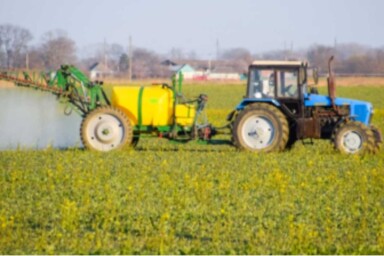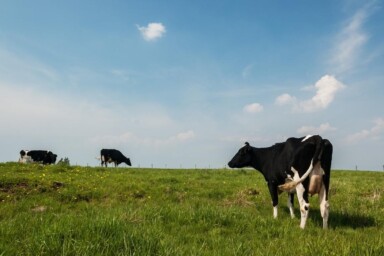On Farming Today this morning, in a conversation about food security and climate change, it was suggested that two fifths of the people on planet earth would not be alive today were it not for the use of mineral fertilisers – an interesting assertion and one with which Malthus might well have agreed, were he still alive.
The issue is important, not least because of the impact of chemical fertilisers on climate change. I read in last weeks’ Farmers Weekly about a farmer who had recently undertaken a carbon audit which concluded that 80% of his emission footprint came from the use of nitrogen fertiliser. Whether or not that is accurate, what is beyond question is that agriculture’s umbilical dependence on nitrogen fertiliser is now being questioned as never before.
After I finished milking and was moving the electric fence for our cows’ daily parcel of mob grazed herbal ley, I was quietly marvelling at the extraordinarily productive capacity of their 12 and a 1/2 acre field. This field has not only produced three excellent cuts of silage but over the last week has fed 80 cows who have produced around 7,000 litres of milk which will convert into around 3/4 of a ton of cheese! All this from the field which has now been around our seven year rotation four times and is more productive than ever.
Marvelling at this productivity, which has been achieved with few external inputs, just crop rotation, herbal leys and recycling of animal manures, I realised that I am in an unusual and interesting position, having been farming without any nitrogen mineral fertiliser for nearly 50 years and observing the impact of my farming practices on yield outcomes. Not many farmers in the developed world can claim to be part of this cohort, since the overwhelming majority of food producers have been nitrogen fertiliser dependent since the post-war period.
So, was Malthus right in his assertion that population would ultimately be limited by the capacity of our agricultural land to feed it? And were his predictions only proved inaccurate because of chemical fertilisers? Quite possibly, but notwithstanding the importance of this question, perhaps there was an even more important issue related to Malthus’s hypothesis which we urgently need to explore over the next five years. Namely, if we switch from chemically dependent agriculture to biologically based farming systems operating in harmony with nature and within planetary boundaries, how much food could we produce on an acre, from a region, a country or the entire planet? And would this be enough to nourish us all? Could we resolve this existential question – which needs to be answered pretty quickly if we are to develop a ‘feeding the world strategy’ – and at the same time address climate change and reverse biodiversity declines?
This question has been preoccupying me for some time. Accordingly, in relation to the UK, we are currently putting the finishing touches to a desk study exploring the question of what foods and in which proportions the UK could produce, if farmed sustainably.
On the ground we have been thinking about these questions through the lens of our own farm, observing the impact of changes in management practices on our productivity. Last year, during the height of the coronavirus pandemic, for various reasons, we stopped making cheese all together for two months and then went to once a day milking for an entire year. These two changes in management practice had a dramatic effect on the amount of food we were producing, reducing it by roughly a third. This reduction was not in any way related to the inherent productivity of our farm but goes to show how much the decisions, skill and management of the farmer is an influence on productivity.
In a more typical year, our food sales amount to 25 tons of cheese, 40,000 litres of milk, meat from 15 dairy cows at the end of their productive lives, around 60 beef-cross and male calves sold to be reared off the farm and perhaps a few pigs and beef animals along with farm vegetables grown for consumption by our family and friends. Of course, there are many other fruits of the land, including berries and apples as well as an abundance of wildlife which coexists with the farming system.
All this information fascinates me, but it is inevitably anecdotal. Hence our decision to scale this up, by mapping the UK as if it was farmed along sustainable lines with a range of different farming systems, each adapted to the inherent productive capacity of the landscape, bearing in mind the climate, soils and other restrictions on food productivity. This work is vital if we are to understand what can be produced sustainably and how we should align our diets with those outputs.
As we go about this research, others are thinking very differently. As an example, the Climate Change Committee have a strategy for feeding Britain which looks very different indeed, involving further intensification on the best soils, reforestation, rewilding and a vast increase in biofuel production.
Next week I’m going to Edinburgh to participate in a countdown to COP 26 Ted event where I will be involved in one of the so-called ‘fishbowl’ discussions. Needless to say, I’ll bring up some of these issues, specifically how we can switch from a situation at present where farming is part of the problem to one where farming can become part of the solution.
I believe there’s not a farmer on the planet who would not like to farm in harmony with nature if they could make it economically viable and, crucially, if they could be sure that such systems could produce enough nutrient dense food to nourish a hungry planet. We hope that our contribution to the TED event, followed by a number of interventions at the Glasgow Summit itself, will help swing the orthodox majority in favour of a more land sharing approach to our food and farming challenge.





